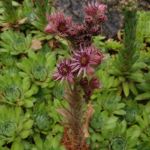| Common Name: |
Common Houseleek |
| Other Names: |
Hens and Chicks. |
| Botanical Name: |
Sempervivum tectorum |
| Genus: |
Sempervivum |
| Family: |
Crassulaceae |
| Native Location: |
S Europe |
| Cultivation: |
Well-drained, gritty or stony soil in sun. May also be planted in crevices of roofing tiles, thatch, walls, and paving. Individual rosettes die after flowering, having produced numerous offsets. Leaves may be damaged by rust (Endophyllum serpervivi). Houseleeks will survive without water for long periods. |
| Propagation: |
By seed sown in spring; by division; by offsets in spring or summer. |
| Harvest: |
Leaves are collected as required and used fresh in infusions, poultices, and tinctures. |
| Height: |
30cm (12in) when flowering |
| Width: |
50cm (20in) |
| Variations: |
Nigrum
Has purple-tipped leaves. |
Red Flush
Has red-green leaves. |
Sunset
Has orange-red leaves. |
|
| Hardiness: |
Z5-10 |
| Parts Used: |
Leaves |
| Properties: |
An astringent, acidic, saline herb that is diuretic and has cooling, soothing, and healing effects. |
| Medicinal Uses: |
Internally, once used for shingles, skin complaints, and hemorrhoids. Externally for stings, bites, warts, burns, sunburns, inflamed or itching skin conditions, and corns. |
| Warning: |
Excess is emetic and purgative. |
| Bibliography: |
Encyclopedia of Herbs by Deni Brown Copyright © 1995, 2001 Dorling Kindersley Limited. pp 365-366 |
